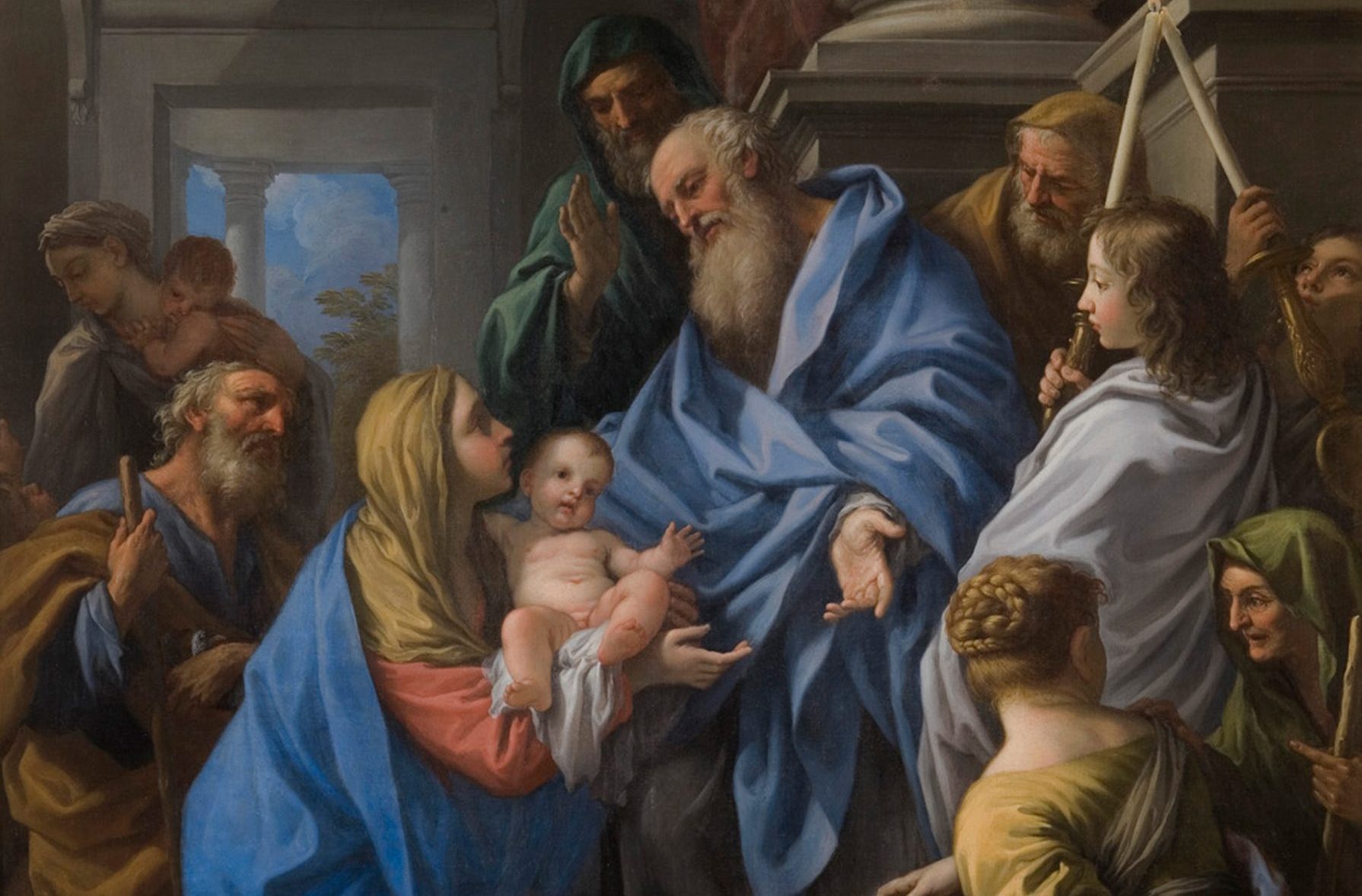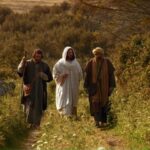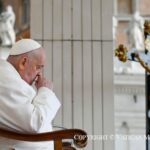Reading time: 7 minutes
Presentation of the Lord: Candlemas
Summary
For the Church of Jerusalem, the date chosen for the Feast of the Presentation was initially February 15, 40 days after the birth of Jesus, which the East then celebrated on January 6, in accordance with Jewish law which imposed this space of time between the birth of a child and the purification of his mother.
When the festival spread to the West in the 6th and 7th centuries, it was brought forward to February 2nd, because the birth of Jesus was celebrated on December 25th.
In Rome, the presentation was combined with a penitential ceremony which was celebrated in contrast to the pagan rites of the "lustrations“. Little by little the celebration took over the procession of penance which became a kind of imitation of the presentation of Christ in the Temple.
Sergius I (687-701), of oriental origin, had the songs of the Greek festival translated into Latin, which were adopted for the Roman procession. In the 10th century Gaul organized a solemn blessing of the candles used in this procession; a century later he added the antiphonLumen ad revelationemwith the canticle of Simeon(Nunc dimittis).

From the homily of Saint John Paul II
Vatican Basilica – Tuesday, 2 February 1993
Dear brothers and sisters,in this solemn celebration of the Feast of the Presentation of Jesus in the Temple, I cordially greet all of you who have come here.
“Moved therefore by the Spirit, he went to the temple” (Lk 2, 27). The words, which we read in the Gospel passage of today's liturgy, refer to Simeon, a pious Israelite who“he was waiting for the comfort of Israel”, that is, the coming of the Messiah. The word of Revelation was entrusted to him at the moment of Jesus' presentation at the temple in Jerusalem, forty days after his birth in Bethlehem.
The evangelist underlines how the Holy Spirit was upon this God-fearing man (cf.Lc2, 26), who had announced to him that“he would not have seen death without first having seen the Messiah of the Lord” (Lk 2, 26).
The evangelist reiterates in particular that Simeon, moved by the Spirit, went to the temple on the day“the parents brought the baby Jesus there to fulfill the Law” (Lk 2, 27).
Together with Simeon the evangelical text also presents the prophetess Anna, thus underlining her participation in the Revelation of the Messiah:“Arriving at that moment, she also began to praise God and spoke about the child to those who were waiting for the redemption of Jerusalem” (Lk 2, 38).
The presentation of Jesus at the temple in Jerusalem is closely connected with the mystery of the Epiphany. The Epiphany in fact highlights the presence and action of the Holy Spirit, who guides men to meet and recognize the Savior and then bear witness to him. The Holy Spirit will descend on the Apostles on the day of Pentecost.
At the moment of the presentation his presence anticipates and prepares that day. He anticipates and prepares, 30 years before, the epiphany on the bank of the Jordan and the entire messianic mission of Jesus of Nazareth. At the same time, the presentation of Jesus in the temple dramatically expresses the modalities of this saving mission.
Addressing Mary, the Mother of Jesus, Simeon says: “He is here for the ruin and resurrection of many in Israel, a sign of contradiction, for the thoughts of many hearts to be revealed”(Lc2, 34-35). Enlightened by the Holy Spirit, Simeon sees in the Child, presented to God by Mary and Joseph, the One who came to take care of the children of Abraham.“Therefore he had to make himself like his brothers in all things, to become a merciful and faithful high priest in things pertaining to God, to make atonement for the sins of the people” (Heb 2:17). But does Simeone already see all this? Does the prophetess Anna really see it too?
The Church, however, finds all this in their testimony. She finds it in Simeone's words. In them the Church also finds a spiritual reference to that temple, whose doors raise their fronts so that the king of glory can enter (cf.Sal24 (23),7); He who, at the same time, is also a sign of contradiction [...] Amen!
©Copyright 1993 – Vatican Publishing House
Forty days after Christmas, the Church celebrates the feast of the Presentation of the Lord, an event which the evangelist Luke speaks of in chapter 2.
In the East the celebration of this festival dates back to the 4th century and since 450 it has been called "Meeting Feast”, because Jesus “encounters” the temple and its priests, but also Simeon and Anna, figures of the people of God.
Around the middle of the 5th century, we also find the festival in Rome. Over time, the blessing of candles will be added to this celebration, to recall Jesus as the "Light of the people".
When the days of their ritual purification were completed, according to the law of Moses, Mary and Joseph brought the child to Jerusalem to present him to the Lord - as it was written in the law of the Lord: "Every firstborn male will be sacred to the Lord" - and to offer as a sacrifice a pair of turtle doves or two young pigeons, as the law prescribes.
Now in Jerusalem there was a man named Simeon, a righteous and pious man, who was waiting for the consolation of Israel, and the Holy Spirit was upon him... Moved by the Spirit, he went to the temple and, while his parents carried the child Jesus to do what the Law prescribed regarding him, he also welcomed him into his arms and blessed God, saying: "Now you can let your servant go in peace, Lord, according to your word, so that my eyes have seen your salvation, prepared by you before all the people: a light to reveal you to the Gentiles and the glory of your people, Israel" (see Luke 2:22-40).
The offer
According to the law of Moses, the firstborn male was the property of the Lord and was destined for the service of the temple. When later the descendants of Levi, the Levites, had taken over the service of the temple, this prescription lapsed, but the firstborn had to be redeemed with a monetary offering for the maintenance of the priest.
The meeting with Simeone
“Moved by the Spirit, he went to the temple.” A detail that should be highlighted is that Simeon moves by inspiration of the Holy Spirit and this explains the "recognition" of Jesus as the Expected One, the light of the people. A Light in front of which we will have to take a stand: “The true light came into the world, the one that illuminates every man... yet the world did not recognize it” (Jn 1,9-10).
A sword will pierce the soul
Simeon blesses both parents, but the words are addressed only to the mother. The child will be a sign of contradiction: Jesus is the light of the world, but she will be rejected; Jesus will be admired and loved, but he will be crucified, defeated; he dies and is resurrected. A path of contradiction, which will mark the heart of the Mother.
The meeting with Anna
The prophetess Anna also arrives at the temple. From the details of the evangelist, it is clear that she too is a woman of God. Very old, widowed. Her being a "prophetess" allows her to see what others struggle to see: the presence of God. She knows how to go beyond appearance and sees in the Child the Expected One of the people.
The amazement
The average age at the time of Jesus was about 40. It is said of Simeon and Anna that they were "old". Usually the elderly live on memories, on nostalgia for times gone by, while young people live on hopes and look forward. In this case we find ourselves faced with two elderly people who look forward in front of the Child, wait and marvel. They sing of joy and hope. Details that make it clear how young they are at heart, because it is a heart inhabited by God and his promises: and God does not disappoint.
Prophets
We are also involved in this "vision". Because those who agree to live the gospel are and will be a sign of contradiction. Taking a stand before the Lord Jesus, Light of the people, requires courage, but even more requires first of all being "of God", like Simeon and Anna.
He also asks for awareness of not always having everything clear, as for Joseph and Mary, who "they were amazed” of what was said and, subsequently, we know that in the face of this fatigue Mary “guarded and meditated”.
source © Vatican News – Dicasterium pro Communicatione





